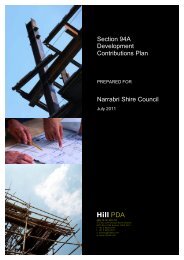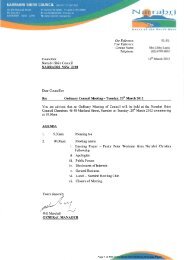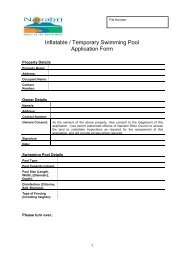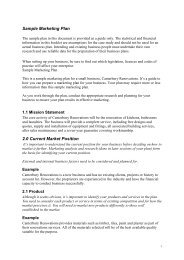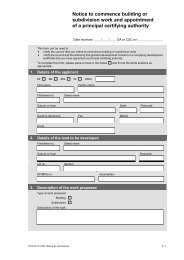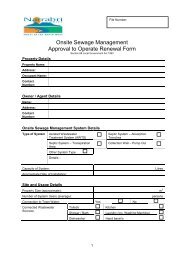Planning for Erosion and Sediment Control on Single ... - Landcom
Planning for Erosion and Sediment Control on Single ... - Landcom
Planning for Erosion and Sediment Control on Single ... - Landcom
You also want an ePaper? Increase the reach of your titles
YUMPU automatically turns print PDFs into web optimized ePapers that Google loves.
Ways you can reduce erosi<strong>on</strong> & c<strong>on</strong>trol sediment<br />
<strong>on</strong> a building or c<strong>on</strong>structi<strong>on</strong> site<br />
Follow these site management practices <str<strong>on</strong>g>and</str<strong>on</strong>g><br />
you will help reduce impact <strong>on</strong> our waterways...<br />
Principles of <str<strong>on</strong>g>Erosi<strong>on</strong></str<strong>on</strong>g> <str<strong>on</strong>g>and</str<strong>on</strong>g> <str<strong>on</strong>g>Sediment</str<strong>on</strong>g> <str<strong>on</strong>g>C<strong>on</strong>trol</str<strong>on</strong>g><br />
1.<str<strong>on</strong>g>Planning</str<strong>on</strong>g><br />
Prepare an <str<strong>on</strong>g>Erosi<strong>on</strong></str<strong>on</strong>g> <str<strong>on</strong>g>and</str<strong>on</strong>g> <str<strong>on</strong>g>Sediment</str<strong>on</strong>g> <str<strong>on</strong>g>C<strong>on</strong>trol</str<strong>on</strong>g> Plan <str<strong>on</strong>g>for</str<strong>on</strong>g> your<br />
site be<str<strong>on</strong>g>for</str<strong>on</strong>g>e works start <str<strong>on</strong>g>and</str<strong>on</strong>g> submit it with your<br />
building applicati<strong>on</strong>. The Plan should show how you will<br />
prevent stormwater polluti<strong>on</strong> throughout the c<strong>on</strong>structi<strong>on</strong><br />
phase <str<strong>on</strong>g>and</str<strong>on</strong>g> until the site l<str<strong>on</strong>g>and</str<strong>on</strong>g>scaping has been completed,<br />
i.e. the erosi<strong>on</strong> hazard has been reduced to an<br />
acceptable level. Different c<strong>on</strong>trols might be necessary<br />
at different stages over the c<strong>on</strong>structi<strong>on</strong> phase as the<br />
nature of the site changes, e.g. changing drainage<br />
patterns, moving stockpiles to different places, etc. If<br />
such changes are likely, these must be shown <strong>on</strong> the<br />
Plan. A model Plan is overleaf. Note that it is made up<br />
of both a Commentary <str<strong>on</strong>g>and</str<strong>on</strong>g> Drawings <str<strong>on</strong>g>and</str<strong>on</strong>g> relates to a<br />
specific site.<br />
2.Installati<strong>on</strong> of <str<strong>on</strong>g>C<strong>on</strong>trol</str<strong>on</strong>g>s<br />
Be<str<strong>on</strong>g>for</str<strong>on</strong>g>e works start, set up the erosi<strong>on</strong> <str<strong>on</strong>g>and</str<strong>on</strong>g> sediment<br />
c<strong>on</strong>trols <str<strong>on</strong>g>and</str<strong>on</strong>g> install a sign warning every<strong>on</strong>e of the<br />
penalties of polluti<strong>on</strong> (this may be provided by council).<br />
Make sure that all site workers underst<str<strong>on</strong>g>and</str<strong>on</strong>g> their individual<br />
resp<strong>on</strong>sibilities in preventing polluti<strong>on</strong>. A recommended<br />
sequence <str<strong>on</strong>g>for</str<strong>on</strong>g> setting up c<strong>on</strong>trols is:<br />
(i) Establish a single stabilised entry/exit point<br />
to the site;<br />
(ii) Install sediment fences al<strong>on</strong>g the low side<br />
of the site;<br />
(iii) Divert upslope water around the site <str<strong>on</strong>g>and</str<strong>on</strong>g>,<br />
if necessary, stabilise the channels <str<strong>on</strong>g>and</str<strong>on</strong>g> outlet;<br />
(iv) Clear <strong>on</strong>ly those l<str<strong>on</strong>g>and</str<strong>on</strong>g>s that must be disturbed<br />
during the building works. Put up a barrier<br />
fence around areas where the vegetati<strong>on</strong> is to<br />
not be disturbed;<br />
(v) Ensure that any stockpiles are <strong>on</strong> your l<str<strong>on</strong>g>and</str<strong>on</strong>g> –<br />
not the footpath or the next-door neighbours<br />
l<str<strong>on</strong>g>and</str<strong>on</strong>g>. Where necessary, seek approval from<br />
Council or your neighbour(s) <str<strong>on</strong>g>for</str<strong>on</strong>g> any offsite<br />
stockpiles. Ensure stockpiles have appropriate<br />
erosi<strong>on</strong> <str<strong>on</strong>g>and</str<strong>on</strong>g> sediment c<strong>on</strong>trols;<br />
(vi) Install <strong>on</strong>site waste receptacles, such as skips or<br />
bins, <str<strong>on</strong>g>and</str<strong>on</strong>g> wind-proof litter receptacles, etc.;<br />
(vii) Start building works;<br />
(viii)<br />
(ix)<br />
Install <str<strong>on</strong>g>and</str<strong>on</strong>g> c<strong>on</strong>nect roof downpipes be<str<strong>on</strong>g>for</str<strong>on</strong>g>e the<br />
frame inspecti<strong>on</strong>; <str<strong>on</strong>g>and</str<strong>on</strong>g><br />
Stabilise any exposed earth banks when the<br />
building works are completed.<br />
3.Maintenance of <str<strong>on</strong>g>C<strong>on</strong>trol</str<strong>on</strong>g>s<br />
All erosi<strong>on</strong> <str<strong>on</strong>g>and</str<strong>on</strong>g> sediment c<strong>on</strong>trol works should be<br />
checked at least <strong>on</strong>ce each week <str<strong>on</strong>g>and</str<strong>on</strong>g> after each<br />
rainfall event to ensure they are working properly.<br />
Maintenance might include:<br />
(i) Removing sediment trapped in sediment<br />
fences, catch drains or other areas;<br />
(ii) Topping up the gravel <strong>on</strong> the stabilised<br />
access;<br />
(iii) Repairing any erosi<strong>on</strong> of drainage channels;<br />
<str<strong>on</strong>g>and</str<strong>on</strong>g><br />
(iv) Repairing damage to sediment fences.<br />
Remember that the erosi<strong>on</strong> <str<strong>on</strong>g>and</str<strong>on</strong>g> sediment c<strong>on</strong>trol works<br />
might need to change as the slope <str<strong>on</strong>g>and</str<strong>on</strong>g> drainage paths<br />
change during the development phase. Best practice<br />
includes anticipati<strong>on</strong> of the likely risks <str<strong>on</strong>g>and</str<strong>on</strong>g> being<br />
prepared <str<strong>on</strong>g>for</str<strong>on</strong>g> unusual circumstances, e.g. having spare<br />
sediment fence material <strong>on</strong> the site.<br />
4.Finalisati<strong>on</strong> of Works<br />
Ensure that the site is stabilised <str<strong>on</strong>g>and</str<strong>on</strong>g> no exposed soil<br />
remains be<str<strong>on</strong>g>for</str<strong>on</strong>g>e removing the erosi<strong>on</strong> <str<strong>on</strong>g>and</str<strong>on</strong>g> sediment<br />
c<strong>on</strong>trols. If l<str<strong>on</strong>g>and</str<strong>on</strong>g>scaping is not completed be<str<strong>on</strong>g>for</str<strong>on</strong>g>e h<str<strong>on</strong>g>and</str<strong>on</strong>g>ing<br />
over the site to the owners, ensure they are aware<br />
of their resp<strong>on</strong>sibilities to prevent polluti<strong>on</strong>.<br />
5.Four Basic Principles<br />
(i) Make sure every<strong>on</strong>e working <strong>on</strong> the site<br />
underst<str<strong>on</strong>g>and</str<strong>on</strong>g>s how important it is to not pollute<br />
stormwater.<br />
(ii) Do not disturb more of the site than you have<br />
to.<br />
(iii) Install erosi<strong>on</strong> <str<strong>on</strong>g>and</str<strong>on</strong>g> sediment c<strong>on</strong>trols be<str<strong>on</strong>g>for</str<strong>on</strong>g>e<br />
starting work.<br />
(iv) Maintain your erosi<strong>on</strong> <str<strong>on</strong>g>and</str<strong>on</strong>g> sediment c<strong>on</strong>trol<br />
works throughout the c<strong>on</strong>structi<strong>on</strong> phase.<br />
DIVERT UPSLOPE<br />
STORMWATER<br />
Where possible to do so, divert<br />
upslope stormwater around around<br />
all l<str<strong>on</strong>g>and</str<strong>on</strong>g>s that do not have a protective<br />
vegetative cover – see St<str<strong>on</strong>g>and</str<strong>on</strong>g>ard Drawing 5-5.<br />
Water sheeting over the ground is <strong>on</strong>e of<br />
the most effective causes of soil erosi<strong>on</strong><br />
<str<strong>on</strong>g>and</str<strong>on</strong>g> should be minimised.<br />
INSTALL A<br />
SEDIMENT FENCE<br />
Install sediment fences downslope<br />
of all disturbed l<str<strong>on</strong>g>and</str<strong>on</strong>g>s to filter coarse<br />
sediment be<str<strong>on</strong>g>for</str<strong>on</strong>g>e it gets into the gutters,<br />
drains <str<strong>on</strong>g>and</str<strong>on</strong>g> watercourses. Details <strong>on</strong><br />
their c<strong>on</strong>structi<strong>on</strong> are shown<br />
<strong>on</strong> St<str<strong>on</strong>g>and</str<strong>on</strong>g>ard Drawings.<br />
3<br />
2<br />
4<br />
1<br />
LIMIT DISTURBANCE WHEN EXCAVATING<br />
Preserve as much of the vegetated area as possible.<br />
Vegetati<strong>on</strong> improves the appearance of the site, greatly<br />
reduces the erosi<strong>on</strong> hazard <str<strong>on</strong>g>and</str<strong>on</strong>g> can be a very effective<br />
natural sediment filter. The erosi<strong>on</strong> hazard of well-vegetated<br />
l<str<strong>on</strong>g>and</str<strong>on</strong>g>s is often less than 1 percent of those that have been cleared.<br />
WASH EQUIPMENT<br />
IN DESIGNATED AREA<br />
Wash all equipment,<br />
including that with c<strong>on</strong>crete<br />
waste in a designated area<br />
that does not drain to the<br />
stormwater system.<br />
5<br />
PLACE SANDS AND SOIL<br />
STOCKPILES BEHIND A<br />
SEDIMENT FENCE<br />
Place all stockpiles totally <strong>on</strong> the<br />
site well away from drainage<br />
paths <str<strong>on</strong>g>and</str<strong>on</strong>g>, where they comprise<br />
erodible materials such as s<str<strong>on</strong>g>and</str<strong>on</strong>g><br />
<str<strong>on</strong>g>and</str<strong>on</strong>g> soil, behind a sediment<br />
barrier – see St<str<strong>on</strong>g>and</str<strong>on</strong>g>ard Drawing 4-1.<br />
Ensure soil <str<strong>on</strong>g>and</str<strong>on</strong>g> cement bags are<br />
covered at the end of each day<br />
if rain or excessive wind are likely.<br />
6<br />
8<br />
RESTRICT VEHICLE<br />
MOVEMENTS TO<br />
A STABLISED ACCESS<br />
Restrict all vehicle movements<br />
<strong>on</strong>to the site to a stabilised access<br />
as shown <strong>on</strong> St<str<strong>on</strong>g>and</str<strong>on</strong>g>ard Drawings.<br />
This allows all-weather entry/exit,<br />
reduces how much soil is carried<br />
to the street <str<strong>on</strong>g>and</str<strong>on</strong>g> may provide<br />
a permanent base <str<strong>on</strong>g>for</str<strong>on</strong>g> the<br />
future driveway.<br />
STORE ALL HARD<br />
WASTE AND LITTER IN<br />
A DESIGNATED AREA<br />
Store all hard waste <str<strong>on</strong>g>and</str<strong>on</strong>g> litter<br />
<strong>on</strong> the site in a way that will<br />
prevent it being blown <strong>on</strong>to<br />
neighbouring l<str<strong>on</strong>g>and</str<strong>on</strong>g>s or washed<br />
into the stormwater system.<br />
LEAVE THE FOOTPATH<br />
VEGETATED<br />
Apart from the stabilised entrance,<br />
maintain a well vegetated (grassed)<br />
footpath. Keeping l<str<strong>on</strong>g>and</str<strong>on</strong>g>s vegetated<br />
is the single most important thing that<br />
can be d<strong>on</strong>e to reduce erosi<strong>on</strong> hazard.<br />
7<br />
<str<strong>on</strong>g>Planning</str<strong>on</strong>g> <str<strong>on</strong>g>for</str<strong>on</strong>g> <str<strong>on</strong>g>Erosi<strong>on</strong></str<strong>on</strong>g> <str<strong>on</strong>g>and</str<strong>on</strong>g> <str<strong>on</strong>g>Sediment</str<strong>on</strong>g><br />
<str<strong>on</strong>g>C<strong>on</strong>trol</str<strong>on</strong>g> <strong>on</strong> <strong>Single</strong> Residential Allotments<br />
All builders/developers are required to prepare an<br />
<str<strong>on</strong>g>Erosi<strong>on</strong></str<strong>on</strong>g> <str<strong>on</strong>g>and</str<strong>on</strong>g> <str<strong>on</strong>g>Sediment</str<strong>on</strong>g> <str<strong>on</strong>g>C<strong>on</strong>trol</str<strong>on</strong>g> Plan showing how<br />
they will minimise soil erosi<strong>on</strong> <str<strong>on</strong>g>and</str<strong>on</strong>g> trap sediment<br />
that may be eroded from the site during the<br />
c<strong>on</strong>structi<strong>on</strong> of a building. The complexity of the<br />
Plan depends up<strong>on</strong> the nature <str<strong>on</strong>g>and</str<strong>on</strong>g> the scale of any<br />
particular development, especially the amount of<br />
l<str<strong>on</strong>g>and</str<strong>on</strong>g> likely to be disturbed. Small-scale development,<br />
such as house extensi<strong>on</strong>s <str<strong>on</strong>g>and</str<strong>on</strong>g> the c<strong>on</strong>structi<strong>on</strong> of<br />
small driveways, may not require a Plan, but should<br />
still be undertaken in a manner which reduces<br />
polluti<strong>on</strong> risk.<br />
The plan should be a st<str<strong>on</strong>g>and</str<strong>on</strong>g>-al<strong>on</strong>e document c<strong>on</strong>sisting<br />
of both drawings <str<strong>on</strong>g>and</str<strong>on</strong>g> a commentary that can be<br />
understood easily by all site workers. This brochure<br />
outlines the in<str<strong>on</strong>g>for</str<strong>on</strong>g>mati<strong>on</strong> to be c<strong>on</strong>tained in a Plan<br />
<str<strong>on</strong>g>for</str<strong>on</strong>g> a single residential allotment. Make sure<br />
every<strong>on</strong>e working <strong>on</strong> the site underst<str<strong>on</strong>g>and</str<strong>on</strong>g>s the Plan<br />
<str<strong>on</strong>g>and</str<strong>on</strong>g> how important it is to not pollute stormwater.<br />
Resp<strong>on</strong>sibilities <str<strong>on</strong>g>for</str<strong>on</strong>g> stormwater management arise<br />
from the Protecti<strong>on</strong> of the Envir<strong>on</strong>ment Operati<strong>on</strong>s<br />
(POEO) Act 1997. One way that you can help to<br />
comply with the POEO Act is to prepare an <str<strong>on</strong>g>Erosi<strong>on</strong></str<strong>on</strong>g><br />
<str<strong>on</strong>g>and</str<strong>on</strong>g> <str<strong>on</strong>g>Sediment</str<strong>on</strong>g> <str<strong>on</strong>g>C<strong>on</strong>trol</str<strong>on</strong>g> Plan that shows how you will<br />
minimise stormwater polluti<strong>on</strong> <str<strong>on</strong>g>and</str<strong>on</strong>g> to implement it<br />
<strong>on</strong>ce approved by Council.<br />
A more detailed Soil <str<strong>on</strong>g>and</str<strong>on</strong>g> Water Management Plan<br />
is required <str<strong>on</strong>g>for</str<strong>on</strong>g> larger-scale developments, where<br />
more than 2,500 square metres of l<str<strong>on</strong>g>and</str<strong>on</strong>g> is to be<br />
disturbed, in accordance with the Managing Urban<br />
Stormwater: Soils <str<strong>on</strong>g>and</str<strong>on</strong>g> C<strong>on</strong>structi<strong>on</strong> document<br />
(L<str<strong>on</strong>g>and</str<strong>on</strong>g>com 2004).<br />
The POEO Act gives Council the powers to issue<br />
cleanup or preventi<strong>on</strong> notices <str<strong>on</strong>g>and</str<strong>on</strong>g> issue <strong>on</strong> the spot<br />
fines of up to $1,500. Higher penalties can be<br />
imposed <str<strong>on</strong>g>for</str<strong>on</strong>g> serious polluti<strong>on</strong> incidents, should<br />
Council launch, prosecuti<strong>on</strong> proceedings within<br />
Court. Cleanup notices are issued to require<br />
cleanup acti<strong>on</strong> when polluti<strong>on</strong> has occurred, while<br />
preventi<strong>on</strong> notices require an activity to be carried<br />
out in an envir<strong>on</strong>mentally satisfactory manner. You<br />
are required to notify your Council when a polluti<strong>on</strong><br />
incident occurs that causes or threatens material<br />
envir<strong>on</strong>mental harm.<br />
Builders/developers have the resp<strong>on</strong>sibility to<br />
manage the following polluti<strong>on</strong> sources:<br />
● air polluti<strong>on</strong>, including dust<br />
● noise that might interfere with neighbouring<br />
properties<br />
● waste discharges including erosi<strong>on</strong> leakage or<br />
spills of c<strong>on</strong>structi<strong>on</strong> materials, soil, s<str<strong>on</strong>g>and</str<strong>on</strong>g>, gravel<br />
slurries <str<strong>on</strong>g>and</str<strong>on</strong>g> c<strong>on</strong>crete<br />
● trade <str<strong>on</strong>g>and</str<strong>on</strong>g> domestic rubbish, including litter<br />
packaging, off-cuts <str<strong>on</strong>g>and</str<strong>on</strong>g> spoiled materials<br />
● toxic chemicals, including fuels, paints, solvents,<br />
sealants, adhesives, lubricants <str<strong>on</strong>g>and</str<strong>on</strong>g> pesticides.<br />
Most of these matters can be addressed in an<br />
<str<strong>on</strong>g>Erosi<strong>on</strong></str<strong>on</strong>g> <str<strong>on</strong>g>and</str<strong>on</strong>g> <str<strong>on</strong>g>Sediment</str<strong>on</strong>g> <str<strong>on</strong>g>C<strong>on</strong>trol</str<strong>on</strong>g> Plan.<br />
© New South Wales Government, 2004
A Model <str<strong>on</strong>g>Erosi<strong>on</strong></str<strong>on</strong>g> <str<strong>on</strong>g>and</str<strong>on</strong>g><br />
St<str<strong>on</strong>g>and</str<strong>on</strong>g>ard Drawings<br />
<str<strong>on</strong>g>Sediment</str<strong>on</strong>g> <str<strong>on</strong>g>C<strong>on</strong>trol</str<strong>on</strong>g> Plan<br />
The Drawing<br />
The Commentary<br />
1. Site works will not start until the erosi<strong>on</strong> <str<strong>on</strong>g>and</str<strong>on</strong>g> sediment c<strong>on</strong>trol works<br />
outlined in clauses 2 to 4, below, are installed <str<strong>on</strong>g>and</str<strong>on</strong>g> functi<strong>on</strong>al.<br />
2. The entry to <str<strong>on</strong>g>and</str<strong>on</strong>g> departure of vehicles from the site will be c<strong>on</strong>fined to<br />
<strong>on</strong>e stabilised point. <str<strong>on</strong>g>Sediment</str<strong>on</strong>g> or barrier fencing will be used to restrict<br />
all vehicular movements to that point. Stabilisati<strong>on</strong> will be achieved by<br />
either:<br />
● c<strong>on</strong>structing a sealed (e.g. c<strong>on</strong>crete or asphalt) driveway to the<br />
street<br />
● c<strong>on</strong>structing a stabilised site access following St<str<strong>on</strong>g>and</str<strong>on</strong>g>ard Drawing<br />
SD 6-14 or other suitable technique approved by the Council.<br />
3. <str<strong>on</strong>g>Sediment</str<strong>on</strong>g> fences (SD 6-8) <str<strong>on</strong>g>and</str<strong>on</strong>g> barrier fences will be installed as<br />
shown <strong>on</strong> the attached drawing.<br />
4. Topsoil from the work’s area will be stripped <str<strong>on</strong>g>and</str<strong>on</strong>g> stockpiled (SD 4-1)<br />
<str<strong>on</strong>g>for</str<strong>on</strong>g> later use in l<str<strong>on</strong>g>and</str<strong>on</strong>g>scaping the site.<br />
5. All stockpiles will be placed in the locati<strong>on</strong> shown <strong>on</strong> the ESCP <str<strong>on</strong>g>and</str<strong>on</strong>g> at<br />
least 2 metres clear of all areas of possible areas of c<strong>on</strong>centrated<br />
water flow, including driveways.<br />
6. L<str<strong>on</strong>g>and</str<strong>on</strong>g>s to the rear of the allotment <str<strong>on</strong>g>and</str<strong>on</strong>g> <strong>on</strong> the footpath will not be<br />
disturbed during works except where essential, e.g. drainage works<br />
across the footpath. Where works are necessary, they will be<br />
undertaken in such a way to minimise the occurrence of soil erosi<strong>on</strong>,<br />
even <str<strong>on</strong>g>for</str<strong>on</strong>g> short periods. They will be rehabilitated (grassed) as so<strong>on</strong> as<br />
possible. Stockpiles will not be placed <strong>on</strong> these l<str<strong>on</strong>g>and</str<strong>on</strong>g>s <str<strong>on</strong>g>and</str<strong>on</strong>g> they will<br />
not be used as vehicle parking areas.<br />
7. Approved bins <str<strong>on</strong>g>for</str<strong>on</strong>g> building waste, c<strong>on</strong>crete <str<strong>on</strong>g>and</str<strong>on</strong>g> mortar slurries,<br />
paints, acid washings <str<strong>on</strong>g>and</str<strong>on</strong>g> litter will be provided <str<strong>on</strong>g>and</str<strong>on</strong>g> arrangements<br />
made <str<strong>on</strong>g>for</str<strong>on</strong>g> regular collecti<strong>on</strong> <str<strong>on</strong>g>and</str<strong>on</strong>g> disposal.<br />
8. Guttering will be c<strong>on</strong>nected to the stormwater system or the rainwater<br />
tank as so<strong>on</strong> as practicable.<br />
9. Topsoil will be respread <str<strong>on</strong>g>and</str<strong>on</strong>g> all disturbed areas will be stabilised<br />
within 20 working days of the completi<strong>on</strong> of works.<br />
10. All erosi<strong>on</strong> <str<strong>on</strong>g>and</str<strong>on</strong>g> sediment c<strong>on</strong>trols will be checked at least weekly <str<strong>on</strong>g>and</str<strong>on</strong>g><br />
after rain to ensure they are maintained in a fully functi<strong>on</strong>al c<strong>on</strong>diti<strong>on</strong>.



